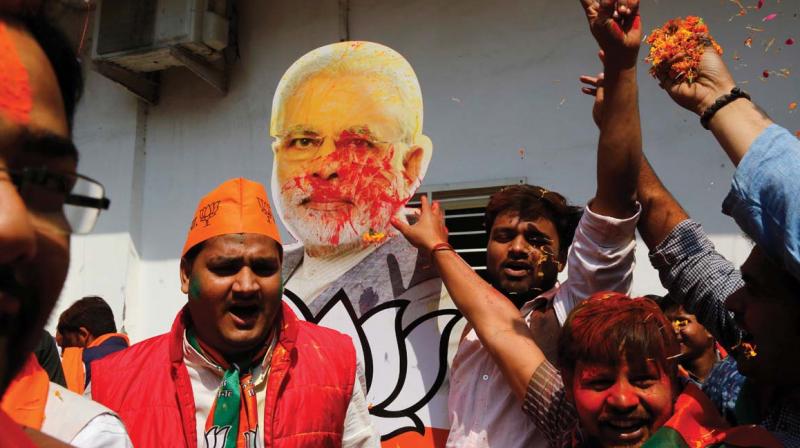Exploring the UP verdict: Days after the wave

Of all the States that went to the polls, Uttar Pradesh was the cynosure of analysts’ eyes. It has given a victory of unprecedented scale to the ruling party, especially to the Prime Minister. One view is that Uttar Pradesh voters have come out of the shell of identity politics and voted for the slogan, Sab Ka Saath, Sab Ka Vikas. The diametrically opposite view is that there is a uniform negative vote in all the five States, with people voting with feet to oust the incumbents. Perfunctorily, both appear to be sound in reasoning. If one looks back into the history many more facts surface. Uttar Pradesh had seen an uninterrupted Congress rule till 1967. With social combinations in favour, Congress could bag majority of seats. With the ruins of Jajmani system still holding, the top and bottom of the caste pyramid kept the Congress vote share safely ahead of that of the others. Later, the revolt of Chaudhary Charan Singh and the empowerment of middle castes (some of them enriched by the Green Revolution) and their carefully woven alliance with Muslim minorities created a powerful counter to the Congress narrative since the late 1960s. But UP’s electoral ground saw the Indira wave in 1971 and a more powerful Janata tidal wave in 1977.
The third wave was in 1984, when Congress won 83 of 85 seats and 50 percent votes. Waves had abated since then to rise again in 2014 and 2017. Political analyst Paul R Brass commented that more than sympathy and hope with Rajiv Gandhi, threat perception regarding the unity and integrity of the country had swayed the voters in favour of the Congress in the aftermath of the assassination of Indira Gandhi. This resulted in a consolidation of majoritarian vote across castes in favour of the Congress and the party could afford to be indifferent Muslim Vote. Whether this hypothesis is correct or not, it has striking parallels with 2017 UP elections. A portion of votes from the core base of identity-based parties, the Brahmin-Thakur base and consolidation of Other Backward castes minus Yadavs, gave BJP 41 percent vote share in 2017. This time also threat perception and appealing to majority community was resorted to.
In a way, the spectre of 1984, has come back to haunt the Congress in 2017. What Garibi Hatao had done in 1971, demonetisation and campaign against 'Black Money' have done this time. Reality check, if any, would come much later. Identity politics, which had stopped BJP for 24years -1993-2017- has lost its steam (though not out of reckoning) in the face of careful social re-engineering, majoritarian slogans and reworking of 1984 strategy of threat perception. How things will emerge seems unclear. A senior journalist predicts that that high expectation can lead to huge disappointment. But the invention of new narratives can still override that. Imagination seems to work very well with the current winners. On the Other side, there appears to be a huge deficit in building counter narratives. It needs to be mentioned that the losing side, SP and BSP have 21.8 and 22.2 percent of vote share, which if combined is more than that of the winner. But politics is not arithmetic alone.
(R. Mohan is a commentator on polity)

